Introduction to the Importance of E-commerce Website Design in the Digital Age
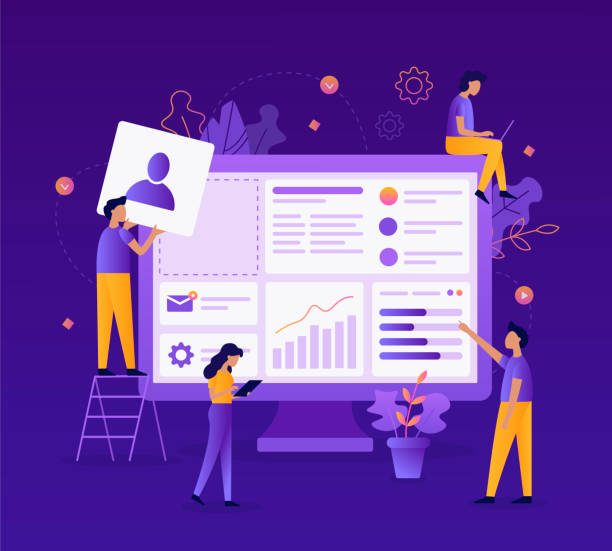
In today’s fast-paced world, an online presence for any business, from small retailers to large corporations, is no longer an option but an undeniable necessity.
#E-commerce is rapidly growing, and the beating heart of this ecosystem is an efficient and attractive #E-commerce_Website.
E-commerce website design is no longer merely about having a few product pages; it means creating a unique user experience that accompanies the customer from the moment they arrive until the purchase is finalized.
Without a strong and optimized e-commerce website design, businesses will lose countless opportunities in competition with rivals.
This is a strategic investment that allows your business to offer its products and services to potential customers worldwide without geographical and temporal limitations.
The importance of a professional e-commerce website became even more apparent during epidemics and physical restrictions; businesses that had already planned for a powerful e-commerce website design were able not only to survive but also to experience significant growth.
Therefore, first and foremost, we must understand that an e-commerce website is not just your virtual storefront, but the backbone of your online sales operations and must be created with comprehensive care and planning.
Did you know that your company’s website is the first point of contact for 75% of potential customers?
Your website is the face of your brand. With **Rasaweb**’s corporate website design services, build an online presence that earns customer trust.
✅ Create a professional and lasting image for your brand
✅ Attract target customers and increase online credibility
⚡ Get free consultation from **Rasaweb** experts!
Essential Steps in Designing an E-commerce Website from Idea to Launch
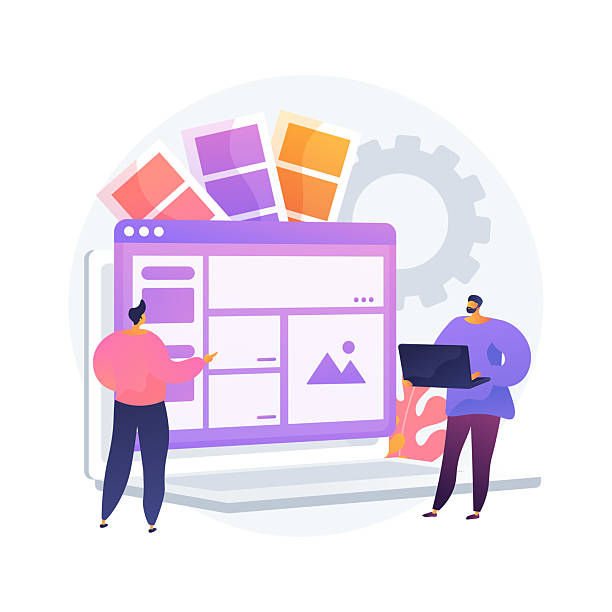
The process of designing an e-commerce website is a set of step-by-step stages that must be carefully planned to achieve the desired outcome.
This process begins from the initial idea and planning phase and continues through launch and support.
The first step is market research and understanding the target audience.
What products will be offered and who are the potential buyers? This stage helps in determining user needs and the necessary features for the website.
The second stage is choosing the right platform, which we will discuss in detail in the next section.
After that, it’s time to design the structure and User Interface (UI) and User Experience (UX).
This section includes page layout, site navigation, and visual design, which must be user-friendly and attractive.
Then, site development and coding are performed, which, depending on the chosen platform, may involve installing and configuring plugins or developing custom code.
At this stage, the proper functioning of the shopping cart, payment gateways, and inventory management system is crucial.
After development, it’s time to input content, including product descriptions, high-quality images, and related articles.
Comprehensive site testing, including performance, security, and responsiveness across different devices, is essential before final launch.
Finally, after launch, continuous monitoring, updates, and technical support are mandatory to ensure optimal performance and site security.
These steps ensure that you will have a powerful and successful e-commerce site.
Choosing the Right Platform for Your Online Store: A Key Decision
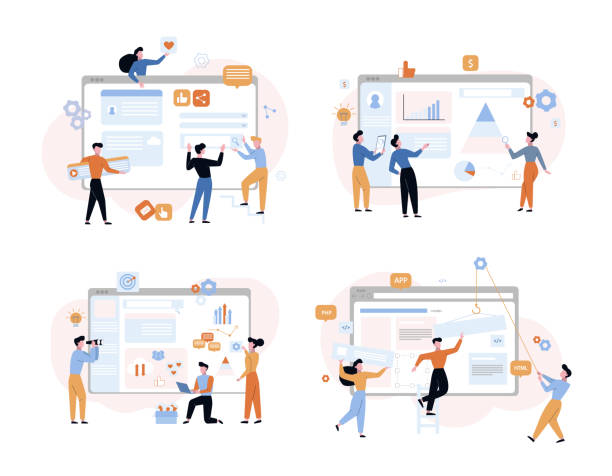
One of the most important decisions in the process of designing an e-commerce website is choosing the right platform.
This choice directly affects the costs, features, scalability, and ease of managing your site.
Various platforms are available in the market, each with its own advantages and disadvantages.
Open-source platforms like WooCommerce, which is a WordPress plugin, offer high flexibility and give you full control over design and features, but require more technical knowledge for setup and maintenance.
On the other hand, SaaS (Software as a Service) platforms like Shopify simplify the setup process significantly by providing ready-made and hosted solutions, and are excellent options for small and medium businesses looking for a quick launch.
Powerful platforms like Magento are also suitable for large companies with complex needs and high scalability, but come with higher complexity and costs.
The platform choice should be based on your budget, business size, existing technical knowledge, and required features.
Are you looking for maximum customization, or is simplicity and speed of launch a priority? Answering these questions will clarify the path to choosing the right platform for your e-commerce website design.
Below you can see a comparative table of popular platforms:
| Platform | Type | Advantages | Disadvantages | Suitable for |
|---|---|---|---|---|
| WooCommerce | Open-source (WordPress) | High flexibility, full control, lower initial costs | Requires technical knowledge, hosting and security responsibility | Small to medium businesses, needing customization |
| Shopify | SaaS (Hosted) | Easy and fast setup, strong support, high security | Less control, monthly costs, limited deep customization | Small to medium businesses, no technical knowledge needed |
| Magento | Open-source (Self-hosted) | Powerful, scalable, advanced features | High complexity, high development and maintenance costs, requires specialists | Large companies, organizations with high sales volume |
User Interface (UI) and User Experience (UX) Design in E-commerce Websites: The Key to Customer Satisfaction
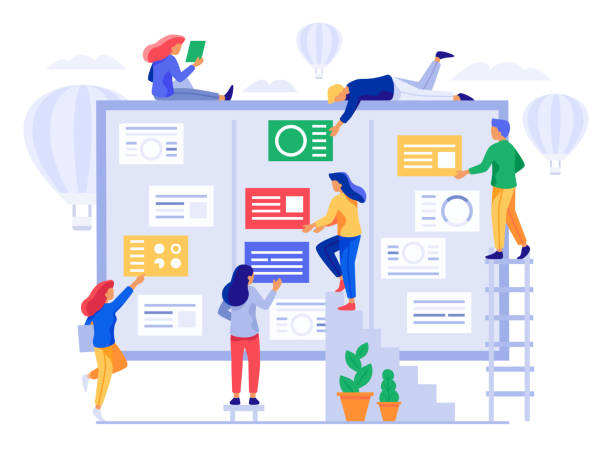
After platform selection, User Interface (UI) design and User Experience (UX) are among the most fundamental parts of e-commerce website design.
UI refers to the visual appearance and elements of the site (such as colors, fonts, buttons, and images), while UX relates to the user’s overall feeling when interacting with the site (such as ease of navigation, loading speed, and purchase process).
An attractive UI can attract customers, but an excellent UX will retain them.
In an e-commerce site, every element must be carefully designed to make the purchasing path smooth and enjoyable for the user.
Simple and understandable navigation, logical product categorization, and advanced search capabilities are prerequisites for good UX.
Also, ensuring the site’s responsiveness (Responsive Design), meaning that your site displays correctly on all devices, from desktops to tablets and smartphones, is crucial.
This is not only important for user experience but also a significant factor in SEO ranking.
The payment process must be simple, fast, and secure, with the fewest possible steps to prevent shopping cart abandonment.
By adhering to UI/UX principles in your e-commerce website design, you can significantly increase your Conversion Rate and attract more loyal customers.
These are the factors that differentiate one online store from another and guarantee its long-term success.
Tired of your company’s website not being seen as it deserves, losing potential customers? Solve this problem forever with professional and effective website design by Rasaweb!
✅ Increase brand credibility and earn customer trust
✅ Attract targeted sales leads
⚡ Contact us now for a free consultation!
SEO for Increased Traffic and Ranking of E-commerce Websites
![]()
After completing the e-commerce website design and preparing it for launch, the next and perhaps most critical step is Search Engine Optimization or SEO.
SEO refers to a set of techniques and strategies aimed at improving your site’s ranking in Google and other search engine results, helping to attract organic and targeted traffic.
For an online store, SEO means ensuring that your products are easily found by potential customers when searching for similar items.
This includes keyword research to find phrases that your customers use to search for products.
These keywords should be used in product titles, descriptions, and meta descriptions.
Technical SEO is also highly important; site loading speed, mobile-friendliness, proper URL structure, sitemap, and robots.txt file all affect how search engines crawl and index your site.
Producing valuable and relevant content, such as blog articles about product usage or buying guides, also helps attract indirect traffic and increase site credibility.
Internal and external linking also plays a significant role in SEO.
Without a strong SEO strategy, even the best e-commerce website design might get lost among a multitude of online competitors.
Investing in SEO is investing in the visibility and long-term success of your online store.
Engaging Content and High-Quality Images in Online Stores: A Factor for Customer Attraction
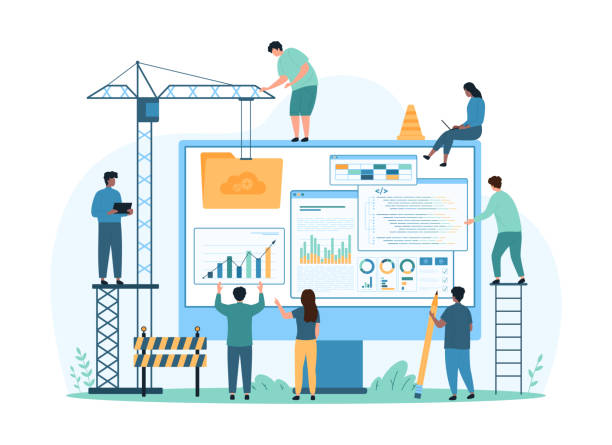
After the technical and visual aspects of e-commerce website design, it’s time for content and images, which play a key role in attracting and persuading customers.
Product content should not just be dry and informational; it must be engaging, persuasive, and informative.
Product descriptions should include all necessary details, benefits, and uses of the product, and answer potential customer questions.
Using storytelling and highlighting unique product features can make the shopping experience much more pleasant for customers.
Alongside text, high-quality images and attractive product videos are incredibly important.
Professional images with high resolution that display the product from different angles help customers gain a better understanding of the product and buy with more confidence.
The ability to zoom in on images, product image galleries, and showing the product in a real environment or on models all help increase customer trust and reduce product return rates.
Short product introduction videos or how-to-use videos can also be very effective.
Remember that many customers are visual and look at images before reading text.
Therefore, the quality and visual appeal of your content should be a top priority.
This aspect of e-commerce website design directly impacts conversion rates and overall customer experience and should not be overlooked.
High-quality content and excellent images make your virtual storefront vibrant and dynamic.
Security and Online Payment Gateways: The Backbone of Customer Trust

Security in e-commerce website design is of vital importance and forms the foundation of customer trust.
In the world of e-commerce, customers entrust you with their personal and financial information, so ensuring the security of this data is a great responsibility.
The first step in ensuring security is using an SSL (Secure Sockets Layer) certificate.
SSL encrypts information between the user’s browser and the website server, preventing unauthorized access to data.
The presence of a green padlock icon in the browser’s address bar is a sign of site security that reassures customers.
Online payment gateways must also be completely secure and reliable.
It is essential to use reputable and well-known payment gateways that comply with security standards such as PCI DSS.
These standards define a set of security requirements for processing credit card information.
Also, protecting customer databases against cyber attacks, using firewalls, and regular backups of site data are other important security measures.
Continuous monitoring of the site to identify any suspicious activity and regular updates of systems and plugins to fix security vulnerabilities are also crucial.
Failure to comply with security issues can lead to loss of customer trust, financial damages, and serious harm to your business’s reputation.
Therefore, security must be prioritized at every stage of e-commerce site building, from initial design to maintenance.
| Security Item | Importance | Description |
|---|---|---|
| Install SSL Certificate | Critical | Data encryption, essential for SEO and trust |
| Use a reliable and secure payment gateway | Very High | Ensuring compliance with PCI DSS standards |
| Regular platform and plugin updates | High | Fixing identified security vulnerabilities |
| Regular data backups | Very High | Data recovery in case of technical issues, attack, or human error |
| Use strong passwords | Medium | For admin panel and user accounts |
| Continuous security monitoring | High | Rapid identification and response to threats |
Marketing and Advertising for Online Store Success After Design
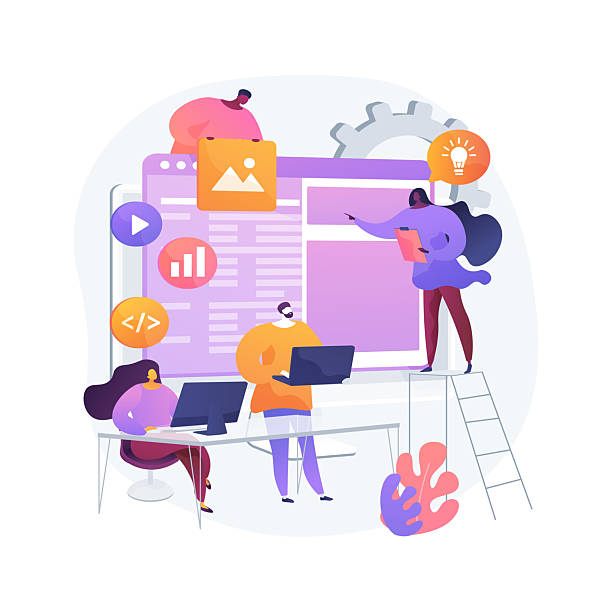
After completing the e-commerce website design, the next and perhaps most important step is digital marketing and advertising to attract customers and increase sales.
No matter how beautiful and functional an e-commerce website is, it will not succeed without visibility.
Marketing strategies must be comprehensive and multi-faceted to target different audiences.
Content marketing, through blogging and producing articles related to your industry or products, helps attract organic traffic and establish your position as an authority in your field.
Social media marketing is also a powerful tool for interacting with customers, building a brand, and driving traffic to your e-commerce site.
Pay-per-click (PPC) advertising campaigns on Google Ads or social media advertising on platforms like Instagram and Facebook can quickly funnel targeted traffic to your site.
Email marketing, through newsletters and special offers, is an effective way to maintain communication with existing customers and encourage repeat purchases.
Analyzing campaign data and performance using tools like Google Analytics is also essential for optimizing strategies and increasing return on investment.
Continuous and dynamic marketing complements the e-commerce website design process and ensures that your design efforts lead to desired sales results.
Did you know that 94% of users’ first impressions of a business are related to its website design? With professional corporate website design by **Rasaweb**, turn this first impression into an opportunity for growth.
✅ Attract more customers and increase sales
✅ Build credibility and trust in the audience’s view⚡ Get a free website design consultation!
Important Tips for Maintaining and Updating Your E-commerce Website for Sustainability

After launching and operating your online store, continuous maintenance and updating are of great importance.
A dynamic and efficient e-commerce website requires constant attention to always perform optimally and not fall behind its competitors.
The first and most important tip is regular updates of the platform, themes, and plugins.
These updates not only add new features but also fix security vulnerabilities.
Ignoring updates can make your site vulnerable to cyberattacks.
Regular backups of all site data, including the database and files, are an undeniable necessity.
In case of any technical problem, cyberattack, or human error, having a backup allows you to quickly restore your site.
Monitoring site performance, including page loading speed, server response time, and accessibility, should also be done continuously.
Various monitoring tools can alert you if any technical issues arise.
Also, site content, especially product information, should be kept up to date.
Adding new products, updating prices, and removing out-of-stock products are among the daily tasks of an online store manager.
Evaluating customer feedback and making necessary changes based on their needs and suggestions also helps continuously improve the user experience.
This active and dynamic maintenance ensures the long-term success and sustainability of your e-commerce website in the competitive market.
The Future of E-commerce Website Design and Upcoming Trends
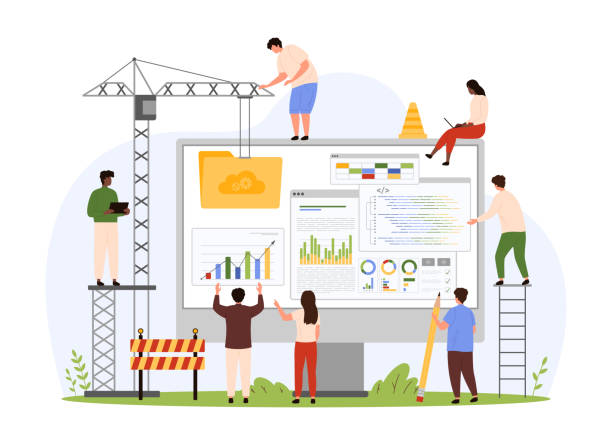
The world of e-commerce is constantly evolving, and e-commerce website design is no exception.
New trends are emerging that are shaping the future of this industry, and businesses must adapt to them to survive and grow.
One of the most important trends is Artificial Intelligence (AI) and machine learning.
AI can revolutionize the shopping experience through personalized recommendations, responsive chatbots, and optimizing the customer journey.
Also, Augmented Reality (AR) and Virtual Reality (VR) have great potential to provide immersive shopping experiences.
Imagine customers being able to virtually view furniture in their homes before buying or trying on clothes in 3D.
Voice search is also gaining popularity, and e-commerce websites should be optimized for it.
The emergence of “Headless Commerce,” which allows the separation of the front-end (visual) of the site from the back-end (database and business logic), provides unprecedented flexibility in design and user experience delivery.
This approach allows businesses to customize the user experience without the limitations of traditional platforms.
Social Commerce also blurs the lines between content and commerce by integrating shopping capabilities into social media platforms.
The future of e-commerce website design is moving towards highly personalized, interactive, and integrated experiences across various channels, and businesses that embrace these trends will be pioneers in this industry.
Frequently Asked Questions
| Question | Answer |
|---|---|
| What is an e-commerce website? | A website that enables the online buying and selling of goods or services. |
| What are the main features of a good e-commerce website? | Easy user interface, product categorization, shopping cart, secure payment gateway, search and filter capabilities. |
| What are common platforms for e-commerce website design? | WordPress (WooCommerce), Shopify, Magento, PrestaShop, etc. |
| Why is responsiveness important for an e-commerce website? | For correct display of the site on all types of devices (mobile, tablet, desktop) and for improving user experience and SEO. |
| What are the benefits of having an e-commerce website? | 24/7 customer access, reduced operational costs, access to a wider market, customer data collection. |
And other services of Rasaweb advertising agency in the field of advertising
Solutions to increase the number of calls received from ads
Role of logo design in attracting attention to manufacturers’ advertisements
Examining the impact of color and font in classified ad design
Using professional photos in ads for HVAC equipment sales
Importance of offering installation and commissioning services in advertisements
And over hundreds of other services in the field of internet advertising, advertising consulting, and organizational solutions
Internet Advertising | Advertising Strategy | Advertorial
🚀 With Rasaweb Afarin, revolutionize your business in the digital world. We pave your path to online success by providing comprehensive digital marketing services, including multilingual website design, SEO, and social media management. For a free consultation and to learn more about our solutions, contact us today.
📍 Tehran, Mirdamad Street, next to Bank Markazi, Kazeroun Jonoubi Alley, Ramin Alley No. 6

